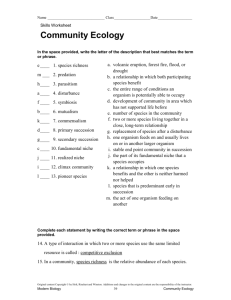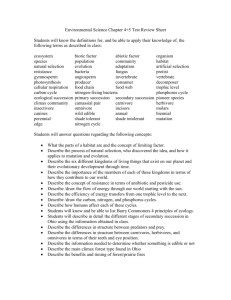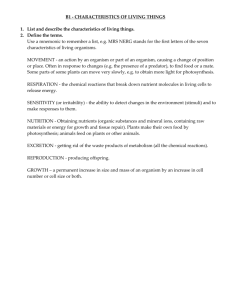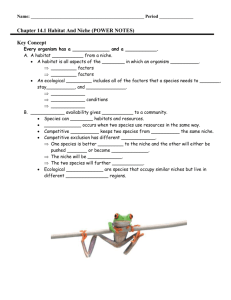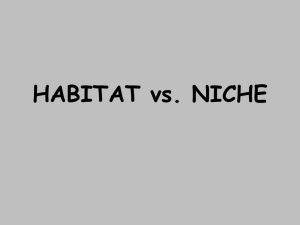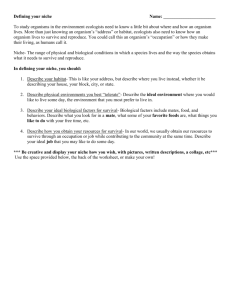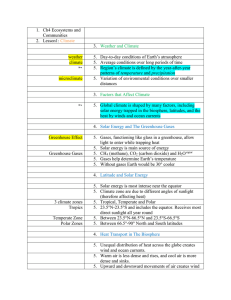PP succeeding a nuclear disturbance 303
advertisement
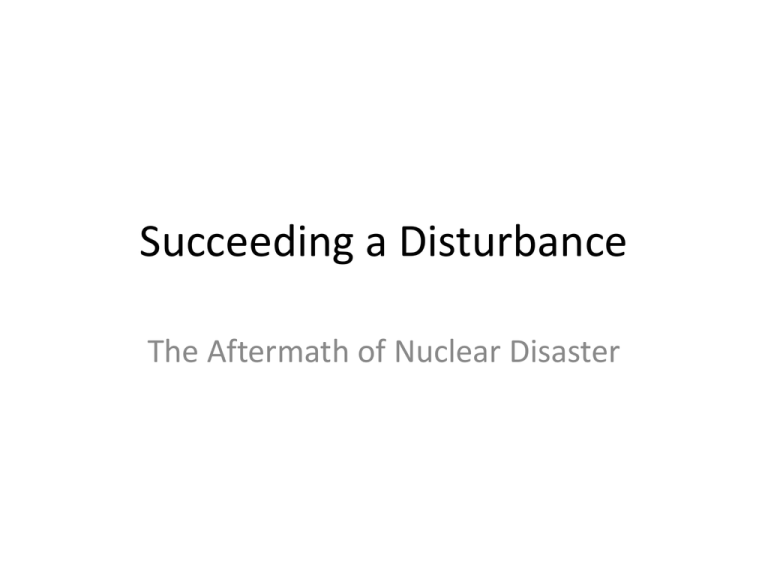
Succeeding a Disturbance The Aftermath of Nuclear Disaster Succeeding a Disturbance Chernobyl Fallout What happens after a disaster? 1. 2. 3. 4. 5. 6. Niche Adaptation Generalist Specialist Invasive species Succession – Primary – Secondary 7. Pioneer species 8. Climax community Words to Define… http://www.youtube.com/watch?v =6XDbcMND7fY • • • • • • • • • • Electricity and Hoover Dam (0-6:00) Sewers Dogs (7:39-12:30) Pests (10:30Succession (-15:30) Invasive mussels and hydroelectric (-18:35) Fires (-19:57) Succession and Central Park (Zoo animals (-22:50 Chernobyl/20 yrs. (23:00-32:48) SPECIALISTS VS GENERALISTS Which type of species tend to do well immediately following a disaster? Long-term? r- Strategist Focus on reprodxn • • • • • • • • • • • Population Strategies Many, small offspring little/no parental care Early reproductive age Most offspring die before reproducing Small adults Adapted to unstable enviro High population growth rate Erratic graph/not at K Generalist Not a good competitor Early successionist K- Strategist Stabilizes at carrying capacity • • • • • • • • • • • Few, large offspring High parental protection Late reproductive age Most offspring reproduce Large adults Adapted to stable enviro Low pop growth rate Stable, S-graph around K Specialist Good competitor Late successionist Remember this???? • A trophic level is an organism’s feeding level. • What trophic level is the organism on your card? Can you make a food chain with all the cards at your table? • Draw the food chain in your book. • Remember what two things you always need! Everything’s connected! What happens if you spray a pesticide to kill the mosquitos? Owl Pellets • What are they? 1. Using forceps, probes, and toothpicks dissect the owl pellet. 2. Sort the bones onto the chart. 3. Draw a diagram of a food web (of at least 5 organisms) with the owl at the uppermost trophic level. What tells you more about a person… • Their address? OR • Their job? What is an owl’s niche? • • • • • Top predator Eats rodents, small birds, snakes, etc. Lives in trees Lays eggs Can fly What defines an organism’s niche? • • • • • • • • • Where it lives What it eats What eats it How it reproduces What nutrients it needs Range of tolerance Range of movement Interactions Role it plays (producer, consumer, scavenger, etc.) Backwards Facts • Play “20 questions” about your niche to define who you are. – Yes or no questions only – No structural questions (Am I bigger than a dog?, Do I look like…?) III. Symbiosis • “Living together” in a long-lasting relationship 3 types Parasitism Mutualism Commensalism Parasitism 1 species (PARASITE) gets nourishment by living on, in, or near another species (HOST) over an extended period of time – Endoparasites – Ectoparasites Rarely Lethal! Why would you kill a good thing? Mutualism • Both species benefit in various ways – Having pollen dispersed for reproduction – Being supplied with food – Receiving protection • Not as much cooperation as exploitation Commensalism • One species benefits, the other is neither helped nor harmed • Clownfish & Sea Anemone – Protection – Feed on anemone’s leftovers Chernobyl 1986 This is an example of what natural process? 2011 ECOLOGICAL SUCCESSION …How nature changes over time TIME Arrange the pics in the correct order… Is it primary or secondary succession? • Depends on starting conditions: – Is there any soil present? – Does not matter if life had been there previously or not Primary or Secondary? Primary or Secondary? Life begins with PIONEER SPECIES • Hardy, small, grows quickly • Breaks down rock to make soil • Makes an area more suitable for other plants • Ex: bacteria, moss, lichens The most mature community is called the climax community Climax Community Plants Dictate Animals Adaptations help an organism maximize their success, but all organisms struggle… • What are some things that limit a population? – These are called limiting factors • The resources available in an ecosystem determine the maximum population that can be supported by the environment over a long period of time – This is called the carrying capacity Analyzing your data 1. Graph the class’s data. – What type of graph do you want? 2. Draw in a horizontal line (make it dotted) to represent carrying capacity – This line is called K 3. Discuss the conclusion questions with your group and be ready to share. EXTRA SLIDES What determines the existence of a population? • 2 opposing forces • BIOTIC POTENTIAL focus is on increasing the organism • How much of yourself can you make? • ENVIRONMENTAL RESISTANCE focus is on limiting the organism • How well can you survive? • Populations strive to find a balance • Different strategies are used to survive GRAPHING POPULATION GROWTH • J- shaped growth young populations will grow exponentially at first. Times are good! • Eventually, environment resists – (too crowded, not enough resources) • TWO CHOICES: stabilize or crash (dieback) • S- shaped curve = stabilizes at carrying capacity (K) – May not be smooth (time-lag) Problem: 2 fundamental niches overlap WHAT IS YOUR SOLUTION? 1. Migrate 2. Change feeding habits 3. Adapt behavior 4. Suffer a sharp population decline 5. Become extinct in that area What type of species overcome this more easily? Generalists or Specialists? Resource Partitioning: The evolutionary result of competition What does this graph say? Keystone Species Succession http://www.world-nuclear.org/info/Safety-and-Security/Safety-ofPlants/Chernobyl-Accident/#.UYgqRMqumSo http://www.douglasstownship.org/files/Limerick%20Area%20Emergency%20Plan ning.pdf Page 6 Happy Anniversary Mt. St. Helen’s (May 18, 1980 eruption) This is an example of what natural process?

